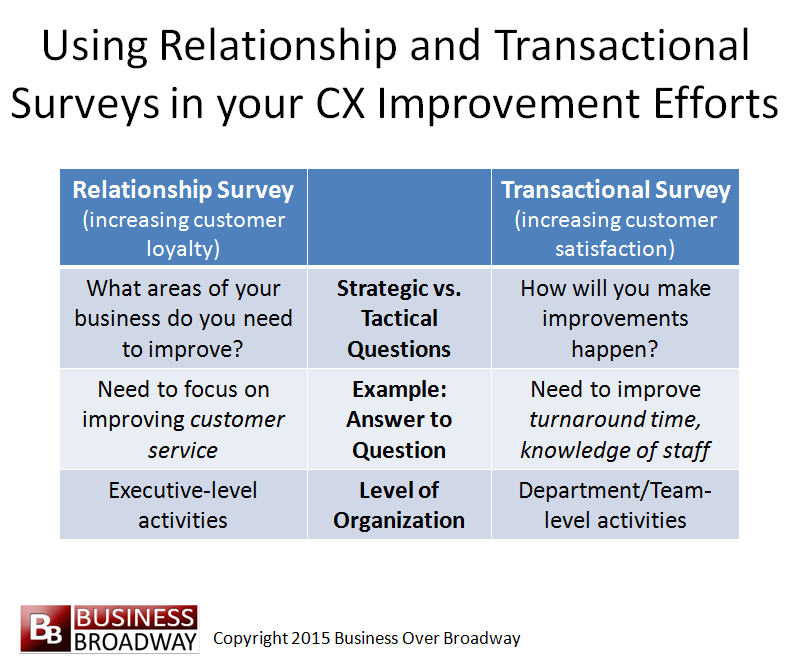Executives use customer surveys to help them improve the customer experience. In this post, I will describe two types of customer surveys, each providing insight to help executives make better, customer-centric decisions. These surveys are relationship surveys and transactional surveys.
Relationship Surveys
Relationship surveys give executives the 30,000 ft view of the customer relationship landscape. Relationship surveys are typically administered at regularly scheduled times over a non-trivial time period (6-12 months). The survey questions let customers indicate their overall satisfaction about their relationship with the company/brand.
Customer relationship questions include four types of questions:
- Customer loyalty – survey questions reflect three general types of customer loyalty: advocacy, purchasing and retention
- Customer satisfaction with the customer experience – survey questions reflect broad touch points across the customer journey (e.g., product, technical support, communication)
- Relative performance – survey questions reflect your ranking against the competition
- Open-ended – survey questions uncover reasons behind the ratings
Relationship surveys are used to understand different CX touch points and how they impact customer loyalty. By applying loyalty driver analysis to these survey data, executives can identify where they need to make customer experience improvements that would optimize ROI.
The customers’ open-ended comments from the relationship survey can be used to identify how those customer experience improvements will look (e.g., We know that service quality needs improvement, but where do we start?). Depending on the open-ended question you ask, customer comments can be a good starting point for generating a list of ways to improve customer satisfaction.
Transactional Surveys
Transactional surveys give executives a closer look at a particular CX touch point. Unlike relationship surveys, transactional surveys are administered immediately or soon after the customer has a specific interaction with the company (e.g., received support, purchased a product, received delivery of product). If relationships measure customer satisfaction about their experience, then transactional surveys measure customer satisfaction in the experience. The survey questions let customers indicate their satisfaction with a specific event/transaction/interaction with the company, typically revolving around a specific customer touch point (e.g., technical support, product, logistics).
Transactional surveys contain four types of questions:
- Overall satisfaction with the event/transaction/interaction – One survey question reflects customers’ overall evaluation of their experience
- Customer satisfaction with customer experience – survey questions reflect specific touch points about the specific experience. These questions can be guided by the results of the review of open-ended comments from the customer relationship survey as well as the results of your journey-mapping exercise.
- Relative performance – survey questions reflect your performance ranking against the competition
- Open-ended – survey questions uncover reasons behind the ratings
While a business needs only one customer relationship survey, they could employ multiple transactional surveys, each corresponding to a specific interaction or touch point. Use the results of the relationship survey (e.g., driver analysis) to identify which transactional survey you need to conduct first. Consider conducting transactional surveys on CX touch points that were identified as key drivers from your relationship survey results (e.g., CX areas that didn’t score high on customer satisfaction and are important to driving loyalty).
Unlike the relationship survey where our focus was to understand the comprehensive customer experience over time, the focus of a transactional survey is on achieving a deeper understanding of what aspect of the experience left them dissatisfied. If the relationship survey identified “technical support” as a key driver, a transactional survey on technical support would help identify the specific ways you can improve technical support quality to improve satisfaction with technical support. The transactional survey helps executives identify how to make improvements happen.
Summary
When you think about customer relationship and transactional surveys, it’s best to think of them as complementary efforts in your quest to improve how you do business. Your relationship survey helps you understand where you need to make improvements (e.g., product, service, marketing) while transactional surveys help you identify what needs to be done to improve those experiences. In other words, relationship surveys provide information to help with CX strategic decisions (e.g., what areas of the business you need to improve); transactional surveys provide information to help with tactical decisions (e.g., how are you going to make CX improvements happen). Figure 1 summarizes how relationship surveys and transactional surveys fit into CX strategic and tactical decision-making.
Conduct the relationship survey first and let those results guide your decision about which transactional survey you need to undertake. Using both survey methods provides necessary insights to help you make better strategic and tactical decisions to enhance the customer experience, improve customer loyalty and drive business success.
Article originally appeared on Clicktools.




 Beyond the Ultimate Question
Beyond the Ultimate Question Measuring Customer Satisfaction and Loyalty (3rd Ed.)
Measuring Customer Satisfaction and Loyalty (3rd Ed.)
[…] Article describes two different types of customer surveys to understand what CX areas to improve and how to improve them. […]